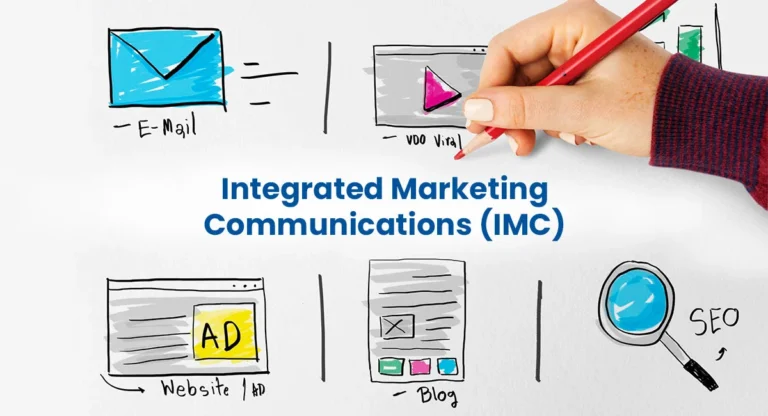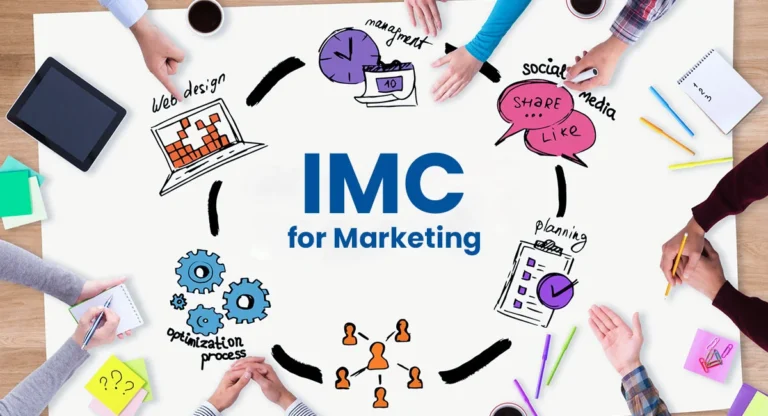Clear communication has always been a fundamental element of thriving businesses.But in a world with ever-evolving consumer behavior, fragmented media platforms, and intense competition, how can companies ensure their message resonates clearly across various channels? The answer lies in Integrated Marketing Communications (IMC).
Table of Contents
The concept of IMC has transformed the way businesses operate, ensuring that all communication strategies are streamlined for maximum impact. This blog explores IMC in business, the full form of IMC, its application as IMC for marketing, and how IMC integrated marketing helps companies achieve consistency and success.

The full form of IMC is Integrated Marketing Communications. It refers to a strategic approach that ensures all marketing and communication activities deliver a unified and consistent message. Whether it’s advertising, social media, public relations, or sales promotions, IMC integrates these channels to work harmoniously toward a common goal.

IMC is about delivering a singular, compelling message that strengthens the brand and resonates with consumers, irrespective of the channel they engage with.
IMC plays a pivotal role in aligning a company’s communication strategy with its overall business objectives. Let’s explore how IMC in business works:
One of the primary goals of IMC is to ensure that a business presents a consistent brand image. Whether it’s a corporate email, product packaging, or a billboard, every element reflects the company’s core values and identity.
By unifying communication efforts, businesses can craft personalized and meaningful interactions with their target audience. This not only fosters trust but also builds lasting relationships.
IMC eliminates duplication and reduces wastage by coordinating all communication efforts under a single strategy. This ensures that resources are utilized optimally.
In highly competitive industries, a clear and consistent communication strategy offered by a digital marketing agency can help businesses differentiate themselves and create a strong market presence.
When applied to marketing, IMC brings together diverse channels and tools, ensuring they work cohesively to maximize impact. Let’s delve deeper into IMC for marketing and its components:
Imagine a company launching a new product. Here’s how IMC for marketing can orchestrate a seamless campaign by aligning efforts across various stages of the funnel, meaning in digital marketing, every step works cohesively toward conversion.
When these efforts are unified under a single theme or message, they create a powerful and cohesive impact.

Developing an IMC strategy requires meticulous planning and execution. Here’s a step-by-step guide:
Understanding who your customers are—demographics, preferences, and buying behaviors—is the foundation of IMC.
What does the business want to achieve? Goals could include increasing brand awareness, driving sales, or enhancing customer loyalty.
The core message should align with the brand’s identity and resonate with the audience.
Identify where your target audience is most active. For instance, professionals might prefer email, while younger audiences may engage more on social media.
Launch the campaign and track its performance using metrics like reach, engagement, and conversion rates.
Implementing IMC offers numerous advantages that can significantly impact a business’s success:
IMC ensures the audience receives a unified message, building trust and strengthening the brand’s identity.
By integrating efforts, businesses can allocate budgets efficiently and avoid unnecessary duplication.
Seamless communication across platforms leads to a satisfying customer journey.
IMC provides a clear framework for tracking the performance of campaigns across various channels.
The global beverage giant used IMC to promote personalized bottles with people’s names. This campaign combined social media, TV ads, outdoor promotions, and experiential marketing to create a memorable and engaging experience.
Apple’s product launches are a masterclass in IMC. From teaser videos and keynote presentations to social media buzz and in-store experiences, the company ensures a unified message across all platforms.
P&G’s “Thank You, Mom” campaign leveraged TV commercials, social media, and event sponsorships to deliver a heartfelt message that resonated globally.
Despite its benefits, adopting IMC is not without its hurdles:
Departments like sales, marketing, and customer service must work together seamlessly, which can be challenging in siloed organizations.
Ensuring that all channels deliver a consistent message requires meticulous planning and constant oversight.
As new platforms and technologies emerge, businesses must continuously adapt their IMC strategies.
Developing and managing an IMC strategy requires significant time, effort, and financial investment.
As the business world evolves, so does IMC. Here are some trends shaping its future:
Artificial intelligence enables businesses to tailor messages based on individual customer preferences, enhancing engagement.
Brands are leveraging AR and VR to create immersive experiences, adding a new dimension to customer engagement.
As platforms like TikTok and WhatsApp gain popularity, IMC strategies must incorporate these channels to remain relevant.
Big data provides insights into customer behavior, enabling businesses to refine their IMC strategies for maximum impact.
Integrated Marketing Communications (IMC) is more than just a strategy—it’s a transformative approach that aligns all marketing efforts to achieve a common goal. From fostering consistent brand messaging to enhancing customer experiences, IMC offers a multitude of benefits for businesses of all sizes.
By adopting IMC, businesses can not only streamline their communication efforts but also create meaningful and lasting connections with their audiences. In a world where attention spans are shrinking, IMC ensures that your brand’s message stands out and resonates.
Would you like a deep dive into any specific aspect of IMC? Let us know in the comments!
Nirbhay Chauhan is a Performance Marketing and ROI Specialist with expertise in SEO, PPC, and media planning. With a passion for data-driven strategies, Nirbhay helps businesses scale by optimizing their marketing efforts to deliver measurable results. His extensive experience in driving online growth and maximizing ROI makes him a trusted partner for businesses looking to elevate their digital presence.